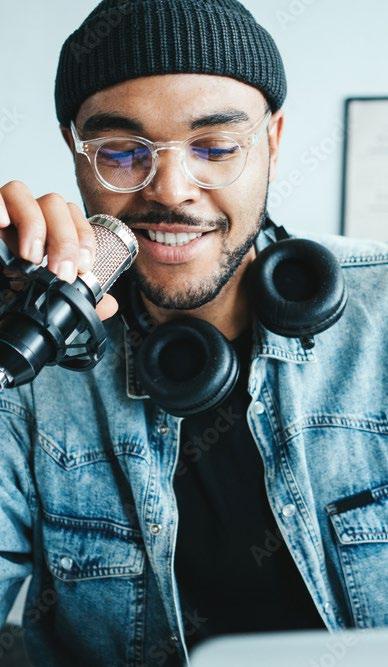
7 minute read
DEFINING YOUR PODCAST

One important step you need to take is to decide exactly what the focus of your podcast is going to be. Ask yourself what the goal of your podcast is. Ultimately, you want to promote your store and build on your sales, but what content do you want to share in order to do that? Focusing only on your store can be limiting. If you want to build an audience, even a small one, you need to post engaging content, on a consistent basis.
“Decide what your podcast is about first, even if it is tempting to just sit in front of a microphone and start talking,” says Jason Klamm, who runs StolenDress Podcast Network, home of such podcasts as Comedy on Vinyl and Dan and Jay’s Comedy Hour. He has produced thousands of podcast episodes and has consulted with notables, such as Craig Ferguson, on launching podcasts. “The subject and purpose of your show can change over time, but you need to start with a seed of an idea. That idea can be the standard-issue ‘I’m going to talk with my friends,’ of course, but you’ll draw more people if the show is about something you’re interested in.”
Klamm says he decided to talk about vinyl comedy records for his first podcast, because it was a topic no one else was covering, he says that was even before the recent comeback vinyl records have experienced.
“I wanted to pick my niche, and less than a year in, I was getting big comedy names on the show,” he says. “Not because I was an expert – it took a few years of doing the show to become one – but because those names liked my interest and wanted to share theirs with me.”
As a billiard retailer, you want to build an audience of people who play pool and other table games. Consider a segment that shares news from the world of billiards or a “This Day in Pool His- tory” segment. One of the best options is to have on guests, especially professional players, or even your customers – when it comes to a good guest for a podcast, fame is nice, but most important is that your guests are good conversationalists. Hearing about a new cue or table from a pro or passionate player is more engaging content than a store owner sitting by themselves, talking about what they sell.
Also keep in mind, every episode shouldn’t be a sales pitch. You want people to listen regularly and share your podcast with others, and the best way to do that is to provide entertaining content on a regular basis – aim for episodes of about 20 to 30 minutes. A lot of people recommend posting episodes weekly, but that can be tough. Every other week should be fine to start, and what’s important is that you post regularly and on schedule.
“Target a specific niche and audience,” Azam says. “Many creators are copying each other, so targeting a specific industry can help a new podcaster stand out. Also, newcomers shouldn’t wait for the audience to find them. Be active in trying to find the audience yourself.”
Time To Record
Now that you have the equipment you need and you know what you want to talk about on your podcast, it’s time to actually talk into that microphone and record your first episode. The good news here is that there are lots of options for doing this, many of which are free.
“I used Zoom to record my podcast for years and then about a year ago, switched to Riverside.fm as it allows me to record video in 9:16 size for Instagram and YouTube Shorts,” Allen says. “With podcasting, you have to have a host site where an RSS feed is created. An RSS feed is like your address, so when you upload your podcast to your host site of choice, it can distribute your recording to iTunes, Spotify, etc. I personally use BluBrry as my host site and am on the $20 per-month plan. I really love their customer service, which is super-responsive and jumped on a Zoom with me to ensure I had everything set up correctly on my end.”
Klamm has some great news when it comes to recording.
“As for recording, that’s probably the simplest part – sit down, hit record on your computer and go,” he says.
All About Editing
With so many people podcasting, you have to have confidence that you can do it, too. But based on what the experts say, one of the toughest parts comes after you record your episodes and start editing them.

“This is a little trickier,” Allen says. “I personally edit my own shows using iMovie on my MacBook Pro. There are editing services out there and you can find folks on Fiverr to do the editing for you.”
Allen releases episodes of his podcast, The Erik Allen Show, every Friday night, and says he prefers to edit shows himself because this way, he’s deciding what the finished episodes are like.
Lewis says that programs like iMovie work well for video podcasting.
“For audio-only, free programs like Audacity exist,” she says. “There are also AI programs, like Podflow, which will correct the audio for you.”
Klamm notes that there are free editing software options.
“One of the most popular options is Audacity,” Klamm says. “You might even record your audio straight into Audacity, save the file, and then cut your podcast from there. If you don’t know anything about audio editing,YouTube has endless tutorials on everything from the bare basics to more involved ways to make your stuff sound good. It can be relatively easy to learn, though it will take some time to have any finesse.”
Azam adds that there are several audio editing options, including Audacity, GarageBand, and Adobe Audition.
“These programs allow you to remove background noise, cut out unwanted parts of the recording, adjust the levels, and add effects like music and sound effects,” he says.
Posting Your Podcast
Azam says that after you’ve finished recording and editing your podcast episode, it’s time to export the audio file in a format like an MP3 or AAC.
“Next, you need to find a podcast hosting platform to upload your audio file to, such as Anchor, Buzzsprout, or Podbean,” he says. “The process to post your podcast on iTunes or Spotify is similar. For example, to submit a podcast on iTunes, you’ll need an Apple ID. After that, you can submit your podcast using the RSS feed. You can find the RSS feed link on your podcast hosting service. For Spotify, the process is almost the same, other than you’ll need a Spotify account instead of an Apple ID. Before submitting, check the requirements outlined by these platforms.”
Klamm says most podcast hosting sites include posting your episodes to Apple Podcasts and other outlets as part of the services they offer.
“When you sign up, you’ll enter your show’s name, your name and other information and they will do a lot of the work for you each time you upload,” he says. “You pay these services a monthly or yearly fee so that they can store your audio files and push them out to the different podcast services, and often to social media to instantly promote your podcasts. There are free services but, as you can guess, those services will be limited as to how long episodes can be, how often you can post episodes, etc. Do your research to find out what fits you best.”
Perfecting Your Podcast
One advantage to starting a podcast that focuses on billiards and your store, is that it targets a specific audience, which Azam says can be a big help.
“Many creators are copying each other, so targeting a specific industry can help a new podcaster stand out,” he says. “Also, newcomers shouldn’t wait for the audience to find them. Be active in trying to find the audience yourself.”
You might also want to consider recording a test episode, to get a feel for putting together an episode without worrying that what you’re recording is good enough to post for the world to hear.
“It allows you to get used to the recording and editing process,” Azam says. “Not to mention, experimenting with different formats and styles can help you develop your own style of content.”

Klamm offers a piece of advice that he wishes someone had given to him, and that is to think of your show in segments.
“Build in breaks and different discussion points to mix it up for your audience and for you,” he says. “This is especially helpful if you decide it’s just going to be you talking – segments keep you from rambling and keep everyone’s interest moving along at a healthy pace. My favorite podcast, for instance, is Stop Podcasting Yourself, which consists of two segments: ‘Get to Know Us,’ where they talk about their lives and those of their guests, and ‘Overheard,’ where they share something funny they’ve overheard. That little bit of segmentation is enough to keep the flow consistent, episode-to-episode.”
Klamm also suggests thinking about the content of your episodes, adding that you may want to occasionally do episodes on topics that may not appeal to tons of people, just because you want to. He does this from time to time and posts those as mini-episodes.They may not get a lot of downloads, but he has fun with them, and they keep his podcast active.
“Try to make your show welcoming without losing your personality, but also listen to feedback,” Klamm says. “Not the unhelpful, ‘You suck’ kind of feedback – this is inevitable because the internet is the internet – but the kind that might surprise you. Maybe there was a word choice you didn’t know could be a problem for some people, maybe you have an uninformed opinion that struck someone as odd. While you can’t tailor every episode to everyone, genuine constructive criticism can make you a better podcaster and will make your show have wider appeal and make more people feel welcomed. After all, you want to expose more people to the thing you want to talk about so much –think about yourself as an ambassador for your passion.”
Lewis says that a typical podcast is easy to put together – once you start doing it and get the hang of it.
“It helps to have someone with experience guide you initially, but unless you have the money to spend, or need the time, there is no need to outsource production once the show is up and running,” she says.
She also warns not to fall for “podcast masterclass traps” in which so-called experts charge podcaster novices for information that’s available online for free.
“It’s different if someone is helping you with pre-production – setting up the intro/outro, finding music, making graphics, etc.,” she says. “Podcasting can easily fall into Nick Offerman’s ‘teach a man to fish’ analogy – ‘Give a man a fish and you feed them for a day. Don’t teach a man to fish and you feed yourself. He’s a grown man, fishing’s not that hard.’ Committing three hours a week to recording, editing, and content creation can give you a full week of content.”










